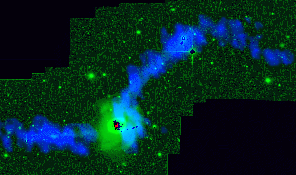
We present the first observations of the neutral hydrogen distribution and X-ray emission in the prototypical merger remnant NGC7252, the ``Atoms-for-Peace'' galaxy. These data are supplemented by accurate B- and R-band surface photometry, reaching a limit of ~26.5 mag arcsec-2, and images taken through a narrow band H-alpha filter. We find all of the 2E9 Mo of atomic gas to be restricted to the outer, tidal regions of this system. By contrast, the molecular gas traced by the CO map of Wang et al. is confined to an inner rotating disk of radius 7" and has an H-alpha counterpart. The gap between the atomic and molecular gas distributions is filled in by diffuse H-alpha emission and perhaps by X-ray emission. The velocity field of the atomic gas in the tidal tails indicates that they are swinging through space in the same sense as the rotation of the inner gas disk. The HI at the apparent base of the northwestern tail seems to be falling back towards the main body of the galaxy, yet there is no HI associated with this main stellar body: this suggests ongoing efficient conversion of the atomic gas into other phases in this region. The H-alpha velocity anomalies previously found in the remnant body may be produced in part by the combination of tail-related, non-circular motions and the inner gas-disk rotation. Both tidal tails have bluer B-R colors than the main body of the remnant, with the bluest regions coinciding with peaks in the gas column density. Each tail contains one giant HII region near the end of its optical light distribution. These HII regions are associated with large concentrations of gas and stars that approach the sizes and gas contents of dwarf galaxies. The HI extends beyond the end of the optical tails and reaches projected distances of 62 kpc east and 120 kpc northwest from the center. We discuss the possible relevance of these data to: (1) the transformation of merged spirals into ellipticals; (2) the generation of ripples by returning tidal material; and (3) the formation of bound stellar systems from tidally torn material.
See also: Dynamical Modeling of NGC 7252 and the Return of Tidal Material , and HI, HII, and R-band Observations of a Galactic Merger Sequence, and Luminosity Profiles of Merger Remnants